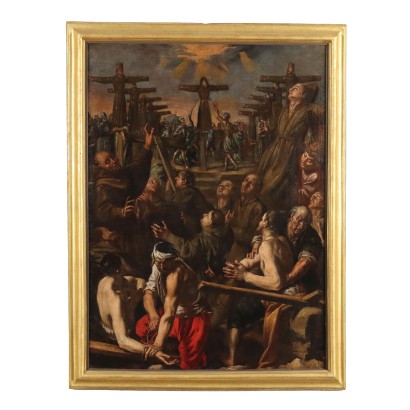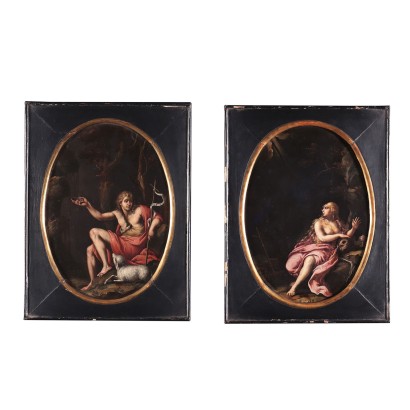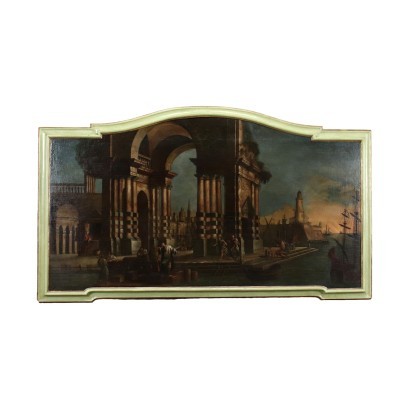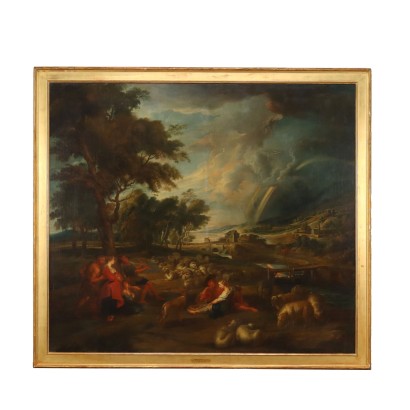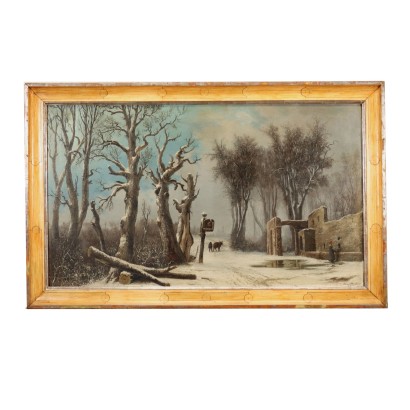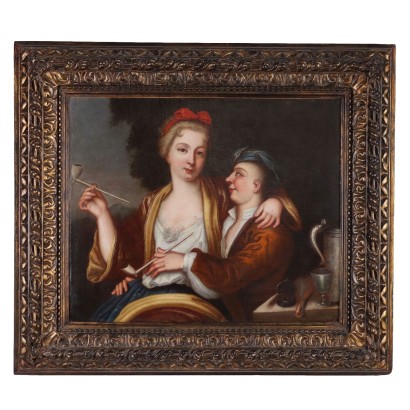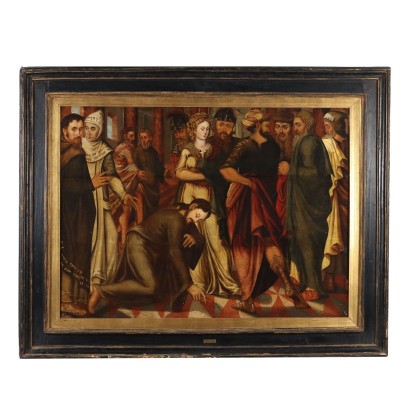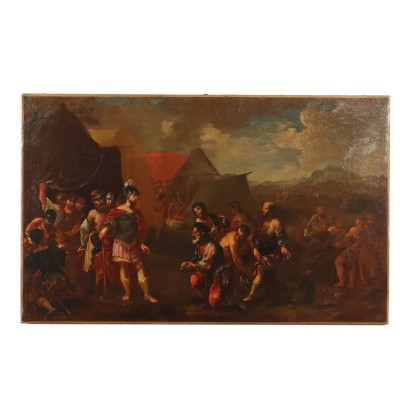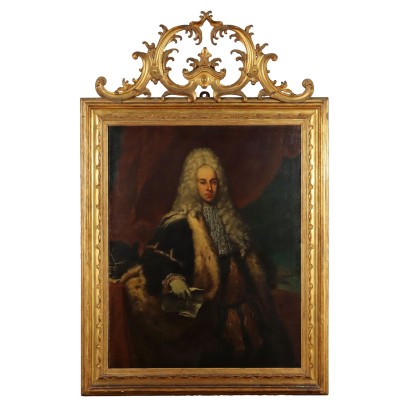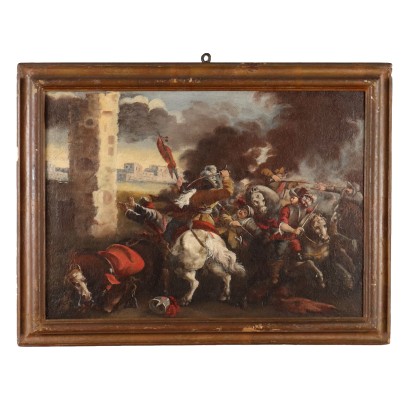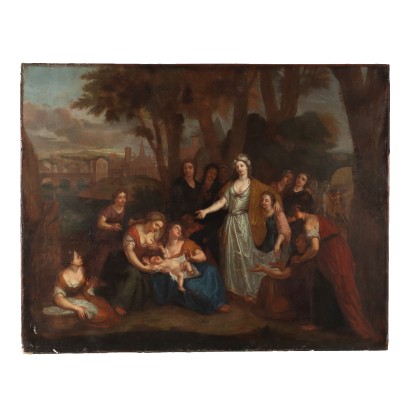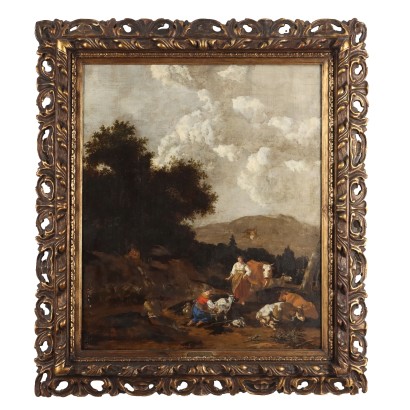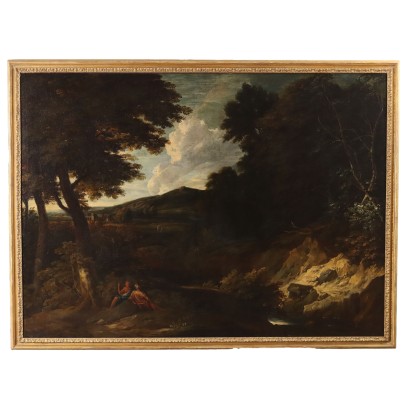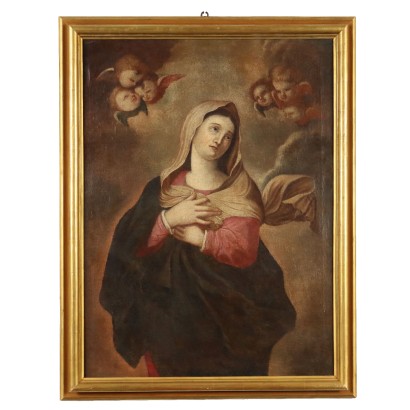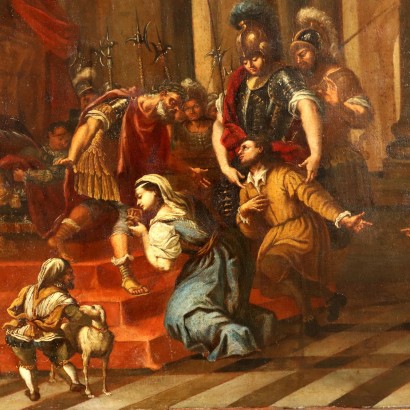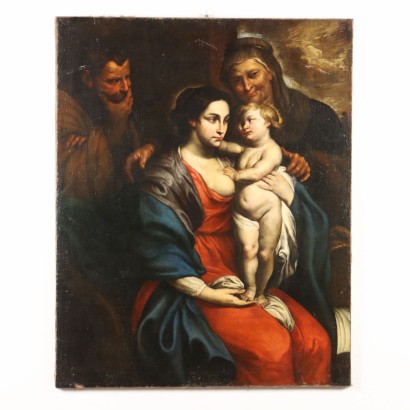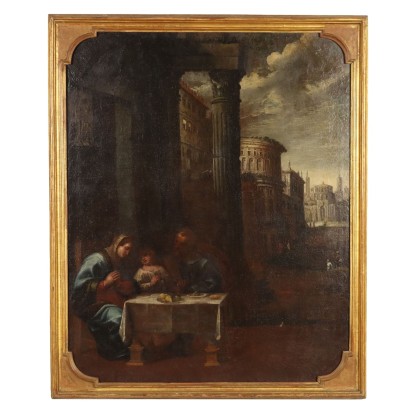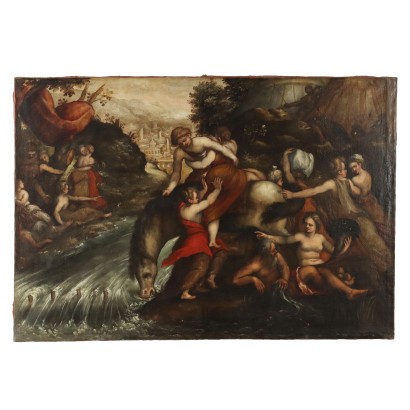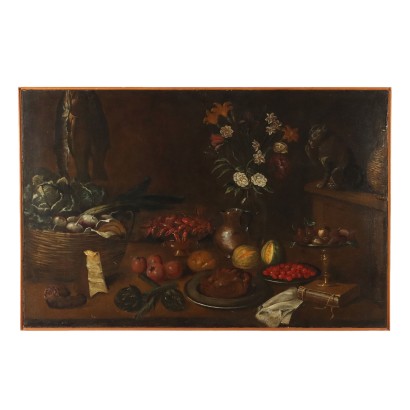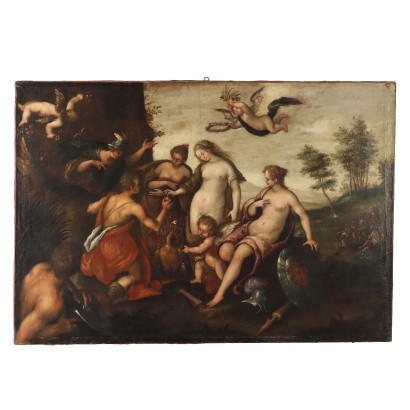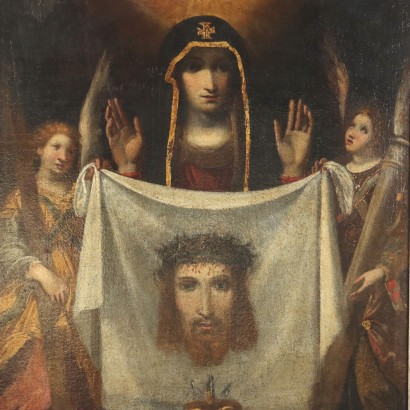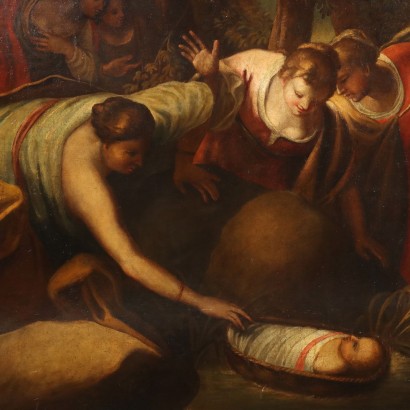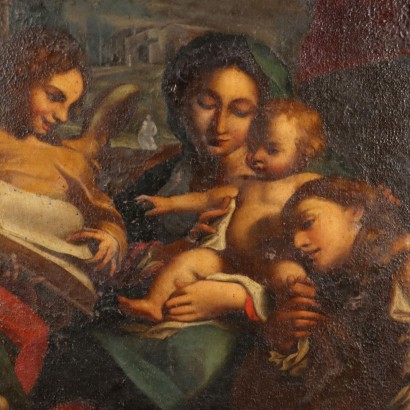Antique Painting Boutique of Tanzio da Varallo Religious Subject - Martyrdom of the Franciscans in Nagasaki
Features
Martyrdom of the Franciscans in Nagasaki
Artist: Tanzio da Varallo (1580/82-1633) Workshop of
Artwork title: Martirio dei Francescani a Nagasaki
Age: 17th Century / 1601 - 1700
Subject: Historical-literary subject
Origin: Lombardia
Artistic technique: Painting
Technical specification: Oil on Canvas
Description : Martirio dei Francescani a Nagasaki
Oil painting on canvas. The work is a faithful copy of the homonymous masterpiece by Tanzio da Varallo (1580-82 /1633), created by the painter from Valsesia for the Franciscan convent of Santa Maria delle Grazie in Varallo, and currently preserved at the Pinacoteca di Brera. The painting depicts the martyrdom which occurred in 1597 in Nagasaki of twenty-three Franciscan friars, who were subsequently beatified in 1627, a date which allows us to place the work in the last years of the artist's activity. Tanzio da Varallo was probably inspired for its creation by the text "Life and exploits of the Martyrs of Japan" by the Spanish Franciscan Marcello di Ribadeneira; of the Brera painting we know a partial preparatory drawing (preserved in the Pinacoteca di Varallo), a sanguine drawing published by Testori (1964) and a canvas (from a private collection in Borgosesia) published by Ferro. The replica proposed here is faithful to the original, even in size, only a few centimeters lower in height, probably lost during the re-lining of the work. Although it is a copy of notable quality, where in particular the richness of highlights stands out which stand out on the warmer and darker tones of the flesh tones, compared to the original one notices a lower fineness of execution, a tendency towards simplification and a pathetic accentuation, which they testify to the hand of a copyist concerned with reproducing the model in every detail, without granting himself any license. Furthermore, this copyist seems to have been very familiar with Tanzio's style, to the point of even perfectly imitating his hooked hands. One can therefore think of a pupil of Tanzio or of his workshop (which was continued by his brother Melchiorre upon Tanzio's death), or of an artist who saw and appreciated his works, such as for example Pietro Francesco Gianoli, who worked above all in churches in Valsesia and in the Novara area and of which other replicas of works by Tanzio da Varallo are known, such as David with the head of Goliath. Furthermore, since the work presented here, before being acquired by a private collector, remained located for centuries in a Franciscan convent in Lombardy, it is plausible that it is a copy of that of Tanzio commissioned by the Order itself, for another monastery, by a painter who was stylistically close to Tanzio and could look to the original. The painting has been relined and restored. It is presented in a late 19th-early 20th century setting.
Product Condition:
Product in good condition, has small signs of wear. We try to present the real state as fully as possible with photos. If some details are not clear from the photos, what is stated in the description applies.
Frame Size (cm):
Height: 122
Width: 92
Depth: 6
Artwork dimensions (cm):
Height: 110
Width: 80
Additional Information
Artist: Tanzio da Varallo (1580/82-1633)
Antonio d'Enrico, known as Tanzio da Varallo, or simply Tanzio, was born in Alagna Valsesia before 1582, and was among the best interpreters of that fervor for artistic renewal which, in Piedmont and Lombardy, was expressed, in different ways, on in the wake of the spiritual legacy of San Carlo Borromeo and the art of the Counter-Reformation. Born to a family of Walser bricklayers and sculptors, he trained together with his brother Giovanni, and left for Rome at the age of eighteen, remaining there for fifteen years, with some occasional trips to Naples and Abruzzo, and having plenty of time to assimilate the language Caravaggesque and then bring it back to its mountains, so much so that it received the nickname "Caravaggio of the Alps". In Tornato in Valsesia, he dealt intensely with works in which his style, of vigorous realism, is combined with a crude investigation of human misery. His acute Caravaggesque personalization in portraying the real data reveals an inclination towards the second Lombard-Piedmontese mannerism of his Lombard contemporaries (Cerano, Morazzone, Procaccini). His main work is the series of frescoes for the chapels of the Sacro Monte di Varallo (made from 1616 to 1628), where he collaborated with his older brother Giovanni d'Enrico. Tanzio died at just 58 years old, in 1633, in the convent of Santa Maria delle Grazie in Varallo.Age: 17th Century / 1601 - 1700
17th Century / 1601 - 1700Subject: Historical-literary subject
Artistic technique: Painting
La pittura è l'arte che consiste nell'applicare dei pigmenti a un supporto come la carta, la tela, la seta, la ceramica, il legno, il vetro o un muro. Essendo i pigmenti essenzialmente solidi, è necessario utilizzare un legante, che li porti a uno stadio liquido, più fluido o più denso, e un collante, che permetta l'adesione duratura al supporto. Chi dipinge è detto pittore o pittrice. Il risultato è un'immagine che, a seconda delle intenzioni dell'autore, esprime la sua percezione del mondo o una libera associazione di forme o un qualsiasi altro significato, a seconda della sua creatività, del suo gusto estetico e di quello della società di cui fa parte.Technical specification: Oil on Canvas
The oil painting is a painting technique using powder pigments mixed with bases in inert and oils.Other customers have searched:
Pittura antica, artisti italiani, pittura olio su tela, arte 800, pittura antica, arte novecento, oggetti d'arte, ritratto di signora, dipinto animali, quadro paesaggio montano, dipinto olio su tela, dipinto antico, dipinti natura morta, quadro antico, quadro del '600, pittori italiani quadri olio su tela paesaggi, paesaggio marino dipinto, paesaggio invernale dipinto, paesaggio autunnale dipinto, dipinto di paesaggio, arte antica, quadro religioso..
Se sei un appassionato d'arte, non perderti i nostri approfondimenti sul Blog Arte Di Mano in Mano e su FineArt by Di Mano in Mano - Arte:
Leggi di più
Ecco alcuni tra i principali articoli:
Vedute
Falsi nell'arte antica
Un messaggio di fiducia per ripartire
La potenza espressiva dell'arte figurativa etiope
Breve Storia del Collezionismo
Giorgio Upiglio, maestro dei libri d'artista
Matthias Withoos detto "Calzetta bianca"
San Rocco pensaci tu - Classic Monday
Dai un'occhiata alle nostre rubriche di divulgazione sull'arte:
Epoche
Lavorazioni e tecniche
Mostre ed Eventi
Protagonisti
Se sei appassionato di pittura antica, con tutta probabilità gusterai le schede di questi stupendi quadri:
"Dio parla a Noè dopo il diluvio", Jacopo da Ponte, detto il Bassano, seconda metà XVI secolo
Crocifissione, maestro della misericordia dell'accademia, terzo quarto del XIV secolo
Erminia incontra i pastori, Camillo Gavassetti, Seconda metà anni Venti del XVII Secolo
Eroine dell'antichità, Francesco Conti, XVIII secolo
Hieronymus III Francken, La Negazione di Pietro, XVII secolo
Jefte e la figlia, Girolamo Forabosco e aiuti, XVII secolo
L'Accademia di Platone, piccolo arazzo, fine XVII - inizio XVIII secolo
Maddalena e San Giovanni Battista
Natura Morta, Bartolomeo Arbotori, XVIII secolo
Sacra Famiglia con San Giovannino, Bartolomeo Ramenghi, scuola di, prima metà XVI secolo
Testa Femminile, Andrea del Sarto, ambito di, post 1522
Uva, fichi, melagrana e pesche su un capitello - Maximilian Pfeiler, primo quarto XVIII secolo
Sapevi che l'arte può essere anche un ottimo investimento (e non solo per grandi portafogli)?
L'Arte tra Collezionismo e Investimento
FineArt: Arte come investimento
Leggi di più
Ecco alcuni tra i principali articoli:Vedute
Falsi nell'arte antica
Un messaggio di fiducia per ripartire
La potenza espressiva dell'arte figurativa etiope
Breve Storia del Collezionismo
Giorgio Upiglio, maestro dei libri d'artista
Matthias Withoos detto "Calzetta bianca"
San Rocco pensaci tu - Classic Monday
Dai un'occhiata alle nostre rubriche di divulgazione sull'arte:
Epoche
Lavorazioni e tecniche
Mostre ed Eventi
Protagonisti
Se sei appassionato di pittura antica, con tutta probabilità gusterai le schede di questi stupendi quadri:
"Dio parla a Noè dopo il diluvio", Jacopo da Ponte, detto il Bassano, seconda metà XVI secolo
Crocifissione, maestro della misericordia dell'accademia, terzo quarto del XIV secolo
Erminia incontra i pastori, Camillo Gavassetti, Seconda metà anni Venti del XVII Secolo
Eroine dell'antichità, Francesco Conti, XVIII secolo
Hieronymus III Francken, La Negazione di Pietro, XVII secolo
Jefte e la figlia, Girolamo Forabosco e aiuti, XVII secolo
L'Accademia di Platone, piccolo arazzo, fine XVII - inizio XVIII secolo
Maddalena e San Giovanni Battista
Natura Morta, Bartolomeo Arbotori, XVIII secolo
Sacra Famiglia con San Giovannino, Bartolomeo Ramenghi, scuola di, prima metà XVI secolo
Testa Femminile, Andrea del Sarto, ambito di, post 1522
Uva, fichi, melagrana e pesche su un capitello - Maximilian Pfeiler, primo quarto XVIII secolo
Sapevi che l'arte può essere anche un ottimo investimento (e non solo per grandi portafogli)?
L'Arte tra Collezionismo e Investimento
FineArt: Arte come investimento
Product availability
The product can be seen at Cambiago
Disponibilità immediata
Pronto per la consegna in 2 giorni lavorativi dalla conferma dell'ordine del prodotto.
Consegna tra i 7 e i 15 giorni in tutta Italia. Per le isole e le zone difficilmente raggiungibili i tempi di consegna possono variare.



